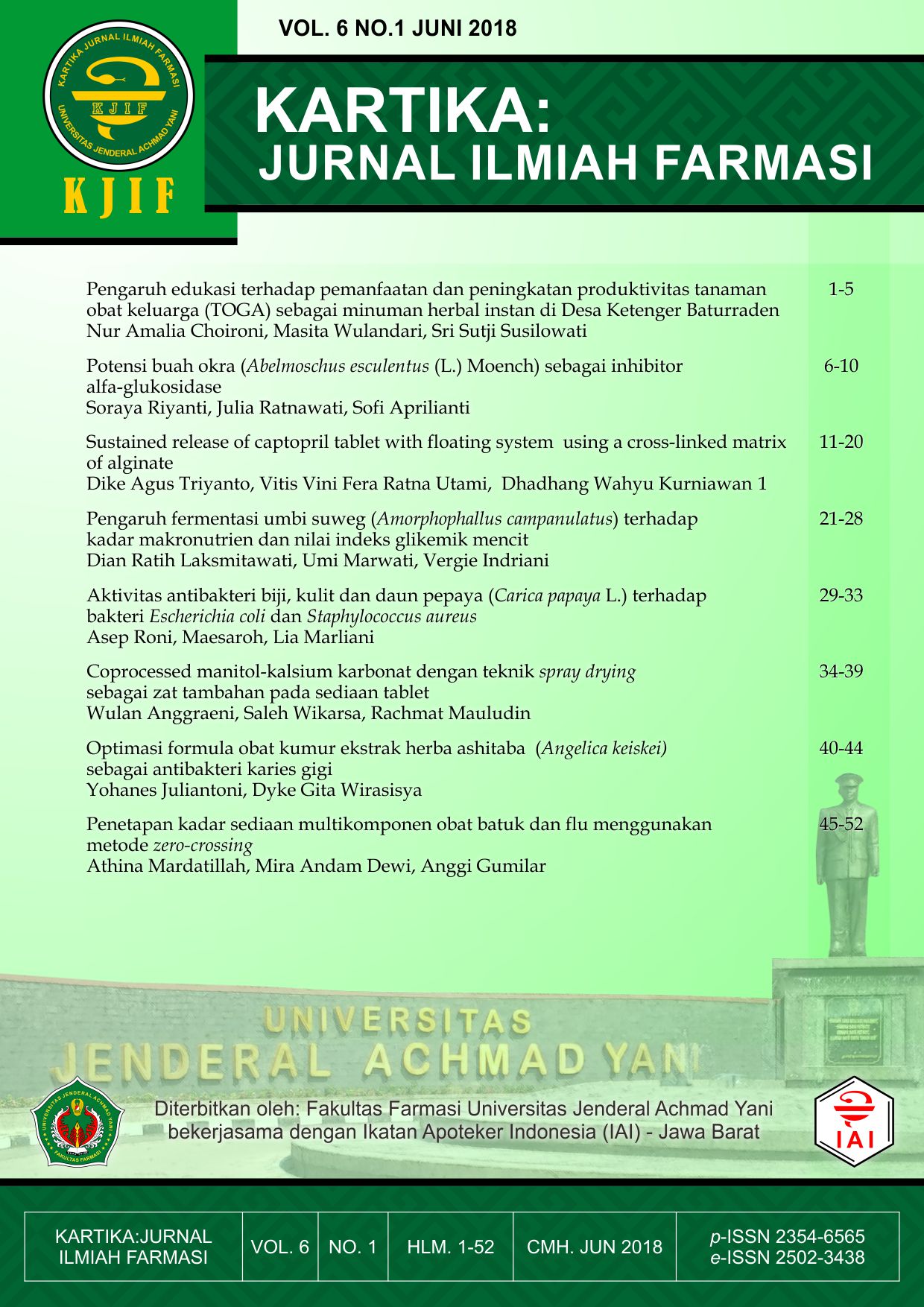Sustained Release of Captopril Tablet with Floating System Using a Cross-Linked Matrix of Alginate
DOI:
https://doi.org/10.26874/kjif.v6i1.123Abstrak
Captopril has a short biological half-life 2-3 hours and has been used for long-term treatment of hypertension. The properties of captopril such as absorbed well in the stomach, freely water-soluble, instability in intestinal environment, and bioavailability about 65%. This study aimed to determine the physical characteristics and drug release profile of captopril tablet sustained release with a floating system using a cross-linked matrix of alginate with calcium chloride as a crosslinker. Matrix system was obtained by forming alginate cross-linked with a calcium chloride. HPMC K4M was used to help cross-linking reaction. Tablet was prepared by wet granulation with varying levels of sodium alginate and calcium chloride. Dissolution test is carried out by paddle method in HCl pH 1,2; 100 rpm; and 37±0,5oC for 8 hours. Amount of captopril released determined by measuring the captopril dissolved using UV spectrophotometry at λ 205 nm. The result showed that this tablet having physical characteristics suitable with the general requirements for tablets. Drug release profile of captopril tablet sustained release with a floating system using a cross-linked matrix of alginate with calcium chloride as a crosslinker capable keeping release of captopril up to 8 hours (third formula) about 51,226% (DE) and followed zero order kinetics.Â
Referensi
Anonymous, 1979, Indonesia Pharmacopoeia, 3rd Edition, Department of Health Republic of Indonesia, Jakarta.
Anonymous, 1995, Indonesia Pharmacopoeia, 4th Edition, Department of Health Republic of Indonesia, Jakarta.
Ansel, H.C., 2005, Introduction of Pharmaceutical Dosage Forms, translated by Farida Ibrahim, 4th Edition, UI Press, Jakarta.
Arora S., Floating Drug Delivery Systems, A Review, AAPS Pharm. Sci. Tech., 2005, 6(3), 372-390.
Banker, G.S., and Anderson, N.R., 1986, Tablet, in Lacman, L., Liebermen, H.A., and Kanig, J.L., Tablet In The Theory and Practice of Industrial Pharmacy, Ed III, translated by Siti Suryatmi, Penerbit Universitas Indonesia, Jakarta, 648, 653, 662,684, 692-707.
Brunetti, M., and Martin, A.S., 2006, Alginate Polymers for Drug Delivery, Worcester Polytechnic Institute.
Chawla, G., Gupta, P., Koradadia,V., and Bansal, A. K., 2003, Gastroretention: A Means to Address Regional Variability in Intestinal Drug Absorption, Pharmaceutical Technology, 50-60, http://www.pharmtech.com (diakses 1 November 2011).
Gandjar, I.G., and Rohman, A., 2007, Analytical of Pharmaceutical Chemistry, Pustaka Pelajar, Yogyakarta, 252-256.
Garg, R., and Gupta G,D., Progress in Controlled Gastroretentive Delivery Systems, Trop. J. Phar. Res. 2008, 7(3),1055-1066.
Gohel, M. C., Mehta, P. R., Dave, R. K., and Bariya, N. H., 2004, A More Relevant Dissolution Method For Evaluation of Floating Drug Delivery System, Dissolution Technologies, Vol. 11, Issue 4, 22-26.
Higuchi, T., 1963, Mechanism of Sustained-Action Medication, Theoritical Analysis of Release of Solid Drugs Dispersed in Solid Matrices, J. Pharm. Sci., Vol. 52, No. 12, 1145-1149.
Khan, C.A., and Rhodes, C.T., 1975. The concept of dissolution efficiency. J. Pharm. Pharmacol., 27, 48–49.
Kroschwitz, 1992, Concise enclclopedia of Polymer Science and Engineering, John Wiley&Sons inc, 213-215.
Lachman, L., Lieberman, H., and Kanig, J., 1994, Industrial Pharmacy II: Theoretical and Practice, translated by Siti Suyatmi, UI Press, Jakarta.
Lieberman, H. A., Martin, M.R., and Gillbert, S.B., 1989. Pharmaceutical Dosage Forms, Disperse System Vol.3. Informa Health Care.
Lipidus, H., and Lordi, N. G, 1968, Drug Release From Compressed Hydrophilic Matrices, Journal of Pharmaceutical Sciences, 1292-1301.
Nur, A. O., and Zhang, J. S., 2000. Recent progress in sustained/controlled oral delivery of captopril, an overview, Int. J. Pharmaceutics, 194, 139-146.
Rowe, R.C., Paul, J.S., and Sian, C.O., 2006, Handbook of Pharmaceutical Excipients Fifth Edition, Pharmaceutical Press and the American Pharmacists Association, USA.
Seta, Y., Higuchi, F., Kawahara, Y., Nishimura, K., and Okada, R., 1988, Design and preparation of captopril sustained release dosage form and their biopharmaceutical properties, Int. J. Pharmaceutics, 41, 245-254.
Shargel, L, 2005, Applied Biopharmaceutics and Pharmacokinetiks, 5th ed, Appleton and Large, New York.
Tønnesen, H.H., and Karlsen, J., 2002, Alginate in Drug Delivery Systems, Drug Development and Industrial Pharmacy, Marcel Dekker Inc, Oslo, 28(6), 623–625 (2002).
Voight, R., 1995, Pharmaceutical Technology Lesson, translated by Soendani Noerono Soewandhi, 5th Edition, 2nd printed, Universitas Gadjah Mada Press, Yogyakarta, 166, 215-218, 223, 570-571, 651,
Wadher, K.J., Kakde, R.B., and Umekar, M.J., 2011. Formulation and Evaluation of Sustained Release Matrix Tablets of Metformin Hydrochloride Using pH Dependent and pH Independent Methacrylate Polymers, British Journal of Pharmaceutical Research 1(2), 33, 2011.
Wagner, J.G., 1971, Biopharmaceutics and Relevant Pharmacokinetics, 1st Edition, Drug Intelligence Publication, Illionis, pp. 115-120.
Wikarsa, S., and Valentina, L.M., 2011, Formulation of Dipyridamol Sustained Release Tablet using Floating System, Makara, Kesehatan, Vol. 15, No. 1, June 2011, 15-20.
Zou, H., Jiang, X., Kong, L., and Gao S,. 2008, Design and evaluation of a dry coated drug delivery system with floating–pulsatile release, J, Pharm., Sci, 97(1), 263–273.
##submission.downloads##
Diterbitkan
Cara Mengutip
Terbitan
Bagian
Lisensi
Penulis yang menerbitkan artikel pada jurnal ini menyetujui ketentuan berikut:
- Penulis memberikan hak cipta dan jaminan atas artikel sebagai publikasi pertama, yang memberikan kesempatan pada orang lain untuk membagi artikel dibawah lisensi Creative Commons Attribution License
- Penulis dapat melakukan perubahan dan menambahkan untuk pendistribusian artikel yang terpublikasi secara non eksklusif (misalnya, mempostingnya ke repositori institusional atau mempublikasikannya dalam sebuah buku), dengan pengakuan publikasi awal dalam jurnal ini.
- Penulis diizinkan dan didorong untuk memposting pekerjaan mereka secara online (misalnya, di repositori institusional atau di situs web mereka) sebelum dan selama proses pengajuan, karena dapat mengarah pada pertukaran produktif, serta kutipan pekerjaan sebelumnya dan lebih besar yang diterbitkan (Lihat The Effect of Open Access).























